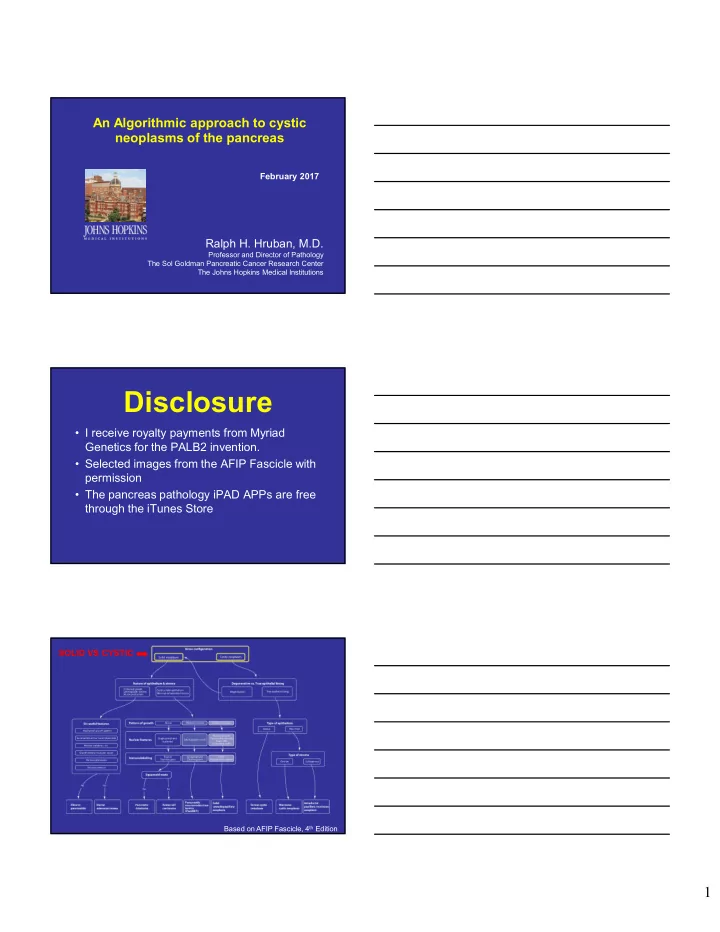

An Algorithmic approach to cystic neoplasms of the pancreas February 2017 Ralph H. Hruban, M.D. Professor and Director of Pathology The Sol Goldman Pancreatic Cancer Research Center The Johns Hopkins Medical Institutions Disclosure • I receive royalty payments from Myriad Genetics for the PALB2 invention. • Selected images from the AFIP Fascicle with permission • The pancreas pathology iPAD APPs are free through the iTunes Store SOLID VS CYSTIC Based on AFIP Fascicle, 4 th Edition 1
1. Is it Solid or Cystic? If Cystic: Truly cystic vs. Degenerative Based on AFIP Fascicle, 4 th Edition 2
Epithelial Lined vs. Degenerative Epithelial Lined vs. Degenerative Degenerative Based on AFIP Fascicle, 4 th Edition 3
Growth Pattern: Insidious Pattern of Invasion 4
Nuclear: Grooves Immunohistochemistry: CD10 Immunohistochemistry: Beta-catenin 5
Solid- Pseudopapillary Neoplasm 6
Foam Cells Foam Cells Cholesterol Clefts Cholesterol Clefts Hyaline Globules Hyaline Globules 7
8
Solid-Pseudopapillary Neoplasm • Clinically, the vast majority occur in young women (20’s) • Patients present with vague abdominal fullness or pain • Grossly well demarcated masses. On cross section, they are cystic and solid with areas of hemorrhage and necrosis 9
Solid-Pseudopapillary Neoplasms: Outcome • All are classified as malignant. • Some may be locally aggressive, but most are surgically cured. Truly Cystic Neoplasms • Gender • Tail vs. Head • Relationship to larger pancreatic ducts • Character of cyst fluid • Lining (serous vs. mucinous vs. none) • Stroma (ovarian-type) 10
Mucinous Intraductal Solid- Serous Cystic Cystic papillary pseudopapillary Neoplasm Neoplasm Mucinous Neoplasm Neoplasm Gender 20:1 1:1.5 10:1 7:3 (F:M) Head/Tail Tail Head Tail=Head Tail=Head Relation to None Always None None Duct Mucinous Mucinous Necrotic/ Serous Cyst Contents Hemorrhagic Epithelium Mucinous Mucinous Non-cohesive Serous Stroma Ovarian None None None True Lining: Serous vs. Mucinous Based on AFIP Fascicle, 4 th Edition 11
Serous vs. Mucinous Serous Neoplasms 12
PAS 13
Serous Cystadenomas Clinical • More common in women than in men • Average age at diagnosis: 61-68 years • Presenting signs and symptoms include: – abdominal pain – weight loss – palpable abdominal mass 14
Serous Cystic Neoplasms do Not Connect with the Major Pancreatic Ducts Oligocystic Serous Cystadenoma Solid Serous Neoplasm 15
Mixed Serous- Endocrine Neoplasm- Think of VHL Serous Cystadenoma Outcome • Several case reports of “multifocal” disease • One or two cases of malignant serous neoplasms • The vast majority of serous cystadenomas are benign, even if incompletely resected 16
Serous Cystadenoma Differential Diagnosis Serous cystadenoma Lymphangioma Cytokeratin + - Glycogen + - Lymphocytes in the wall - + Mucin-producing Neoplasms (MCNs and IPMNs) 17
Mucinous: Ovarian Stroma? Based on AFIP Fascicle, 4 th Edition Nature of the Stroma: Ovarian vs. Collagenous Mucinous Cystic Neoplasms 18
Mucinous Cystic Neoplasms • Much more common in women than in men • Mean age at diagnosis: ~50 (younger than for patients with serous cystadenomas) • Tail > Head 19
20
Section 108 21
Mucinous Cystic Neoplasms • Low-grade Dysplasia • Intermediate grade Dysplasia • High-grade Dysplasia • Invasive Carcinoma Mucinous Cystic Neoplasms- Proposed • Low-grade Dysplasia • High-grade Dysplasia • Invasive Carcinoma Progesterone Receptors 22
Estrogen Receptors One-third of MCNs have an associated invasive ductal adenocarcinoma MCNs are Unifocal Noninvasive 100 Survival (%) 50 IPMN MCN 0 0 5 10 15 Years A. Pea, Annals of Surgery, 2016 23
Completely resected and entirely examined mucinous cystic neoplasms without an associated invasive carcinoma follow benign courses. Because invasive carcinoma can be focal, failure to study an entire mucinous cystic neoplasm may result in the miscategorization of a malignant tumor as benign. Collagenous Based on AFIP Fascicle, 4 th Edition 24
Intraductal Papillary Mucinous Neoplasm IPMNs form Long finger- Like papillae Intraductal Papillary Neoplasms • Long history of symptoms • Incidence in men equals that in women • Head > Tail • Mucin oozing from the ampulla of Vater 25
IPMN 26
Branch Duct IPMN 27
IPMNs involve the ducts histologically IPMNs involve the duct system 28
Intraductal Papillary Neoplasms • IPMN with low-grade dysplasia • IPMN with intermediate dysplasia • IPMN with high-grade dysplasia • IPMN with an invasive carcinoma Colloid Tubular/ductal Intraductal Papillary Neoplasms Proposed • IPMN with low-grade dysplasia • IPMN with high-grade dysplasia • IPMN with an invasive carcinoma Colloid Tubular/ductal 29
One-third of IPMNs are Associated with an Invasive Colloid or Ductal Adenocarcinom a 30
Extrusion of Mucin into the Stroma IPMNs Can Be Multifocal Multifocality is Clinically Important Kaplan- Meier Survival Noninvasive 100 Survival (%) 50 IPMN MCN 0 A. Pea, Annals of 0 5 10 15 Years Surgery, 2016 31
Recurrence of Disease in the Remnant Pancreas is a Big Problem for Patients with an IPMN A. Pea, Annals of Surgery, 2016 Intraductal Papillary Mucinous Neoplasms Surgically resected non-invasive IPMNs have a 90% 5-year survival rate. Most of the recurrences in patients with non-invasive IPMNs appear to be from multi-focal disease, because patients who undergo total pancreatectomy for a non-invasive IPMN have a close to 100% 5-year disease free survival Clinical Implications A. Pea, Annals of Surgery, 2016 32
Invasive Carcinoma Arising in IPMN vs. MCN Invasive 100 MCN Survival (%) 50 IPMN 0 0 5 10 15 Years A. Pea, Annals of Surgery, 2016 Mucinous Cystic Intraductal Papillary Neoplasm Mucinous Neoplasm Age 40-50 years 60’s Gender Female>>male Male>female Head vs. body/tail Body/tail Head Connectivity to Usually not Always large ducts Cyst Contents Mucoid Mucoid Mucin oozing from No Yes ampulla Stroma Ovarian-type Collagen Multifocal disease Very rare 20-30% 33
Based on AFIP Fascicle, 4 th Edition 34
35
36
Follow us on Twitter- @Hopkins_GI_Path 37
Recommend
More recommend